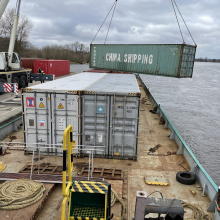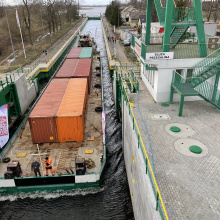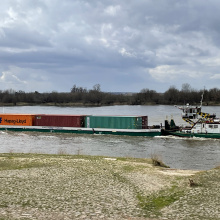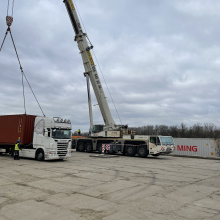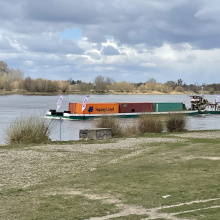- 'Container shipping on the Vistula, like on the Oder, has great potential, but not in all cases. This applies mainly to cargo that is not time-sensitive, but lower costs are more important for them,' - says dr hab. Ernest Czermański prof. UG from the Faculty of Economics UG. The cruise of a barge with containers on the Vistula River has finished. It aimed to establish whether at the present level of navigability of the river there is a potential for development of this type of transport.
The cruise was prepared and organised as part of the EMMA - Extenssion project carried out by the local government of the Kuyavian-Pomeranian region. It was the first one that concerned full containers carried out on a commercial basis. It is worth emphasizing that the preparatory works and the initiative of the cruise were created on the occasion of the COMBINE project carried out with the participation of the University of Gdańsk, headed by prof. Ernest Czermanski from the Faculty of Economics of the University of Gdańsk.
The idea of a commercial voyage was born on the occasion of economic analyses prepared by the project team and the key element was to acquire an intermodal operator. This was undertaken by the company VAN Cargo Gdynia Branch, where Jakub Jankiewicz, an expert on COMBINE project at UG, is the head of the intermodal section.
The trip aimed to identify the conditions for carrying out inland waterway transport on the Vistula River in the current technical and economic conditions. The aim was to determine whether, at the current level of navigability of the Vistula, there is potential for the development of barge transport. - 'Container shipping on the Vistula, as on the Oder, has considerable potential, but not in all cases. This applies mainly to cargo that is not time-sensitive, but for which lower costs are more important, or the fact that they are part of the process of reducing emissions into the atmosphere, or a conscious green logistics policy of the cargo manager,' - explains prof. UG Ernest Czermański.
Let us recall that the barge with six 40-foot containers (12 TEU) covered the route from Gdańsk to Chełm and back. In Chełmno, unloading and loading took place. The total journey time to Chelmno was 17 hours, while the return journey took just 10 hours. During the night the barge stood at the lock in Przegalin. Transhipment time - 1.5 hours at the GTK terminal with a harbour crane on the outward leg, only 0.5 hours with an overhead crane on the return leg and about 3.5 hours in Chełmno with a single crane.
As the cruise organisers emphasise, the difference in fuel consumption is a ratio of about 1:4 due to the river current. The organisation of the voyage required the preparation and coordination of many elements and subcontractors (the river carrier, the heavy self-propelled crane, the road carriers and the GTK terminal itself in the port of Gdańsk).
The voyage proved that even with the current state of technical infrastructure it is possible to carry out inland shipping on the Vistula. These transports can be price-competitive as compared to road transport, and even due to short distance as compared to rail transport. - 'Last week we already received a dozen or so enquiries concerning the possibility of transporting cargo via the Vistula. Both containerised and conventional general cargo (big bags, bundles etc.). This is a sign that the market is looking for and needs solutions other than road transport,' - says Jakub Jankiewicz.
The potential for container transport exists under current conditions and with a fleet of 52 TEU per voyage using a combination of a Tur pusher and four Galar barges. These values can be easily doubled by stacking containers. The voyage also confirmed the need for building a river terminal in Solec Kujawski.
- 'It is interesting that this voyage also showed the level of dependence of the global transport system extending even to this type of relations,' - explains prof. UG Ernest Czermański. - 'There would have been more containers on this voyage if not for the recent Suez Canal blockage and week-long delays of ships carrying containers to the Gdańsk DCT destined for this voyage.'
Prof. UG Ernest Czermanski, argues that water transport is the most ecological form of transport and refutes the accusations of ecologists who raise the issue of protecting the original nature of the river. - 'The activities of ecologists in this particular case seem to be unjustified, because in fact they paradoxically lead to an increase in atmospheric emissions, an increase in the risk of road accidents, wear and tear on the road infrastructure, and noise and vibration emissions,' - he argues.
The professor stresses that we should remember that it is us, the consumers, who generate trade turnover and related transport: - 'It depends on our conscious attitude, whether and from where these goods will be imported. And we should demand from the transport industry that it transports goods in a way that has the least negative impact on the environment and society. And this is already happening to a large extent.'

